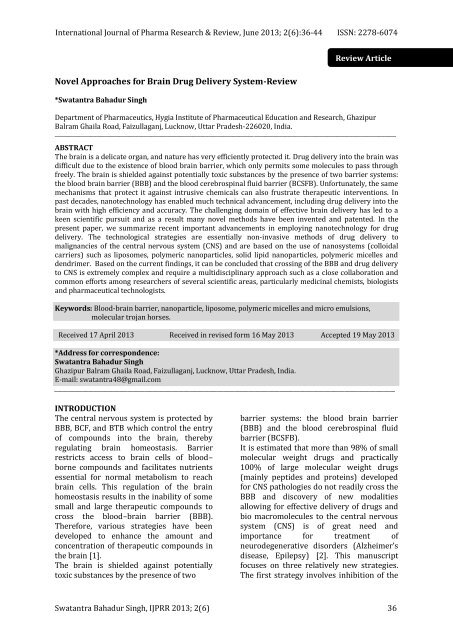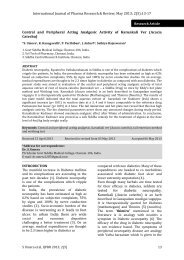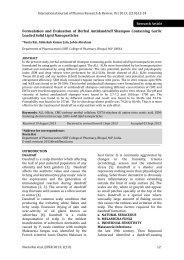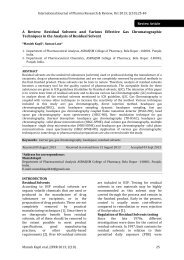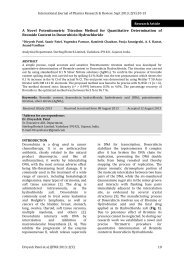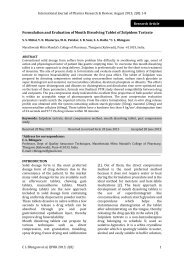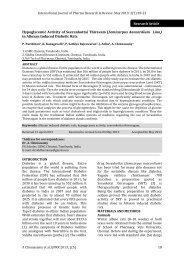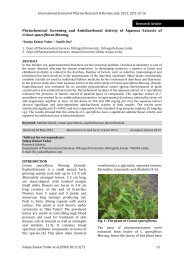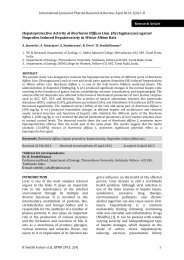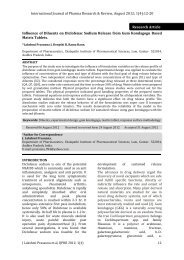Novel Approaches for Brain Drug Delivery System-Review
Novel Approaches for Brain Drug Delivery System-Review
Novel Approaches for Brain Drug Delivery System-Review
- No tags were found...
You also want an ePaper? Increase the reach of your titles
YUMPU automatically turns print PDFs into web optimized ePapers that Google loves.
International Journal of Pharma Research & <strong>Review</strong>, June 2013; 2(6):36-44 ISSN: 2278-6074<strong>Novel</strong> <strong>Approaches</strong> <strong>for</strong> <strong>Brain</strong> <strong>Drug</strong> <strong>Delivery</strong> <strong>System</strong>-<strong>Review</strong>*Swatantra Bahadur Singh<strong>Review</strong> ArticleDepartment of Pharmaceutics, Hygia Institute of Pharmaceutical Education and Research, GhazipurBalram Ghaila Road, Faizullaganj, Lucknow, Uttar Pradesh-226020, India._____________________________________________________________________________________________________________________________________________________________________________ABSTRACTThe brain is a delicate organ, and nature has very efficiently protected it. <strong>Drug</strong> delivery into the brain wasdifficult due to the existence of blood brain barrier, which only permits some molecules to pass throughfreely. The brain is shielded against potentially toxic substances by the presence of two barrier systems:the blood brain barrier (BBB) and the blood cerebrospinal fluid barrier (BCSFB). Un<strong>for</strong>tunately, the samemechanisms that protect it against intrusive chemicals can also frustrate therapeutic interventions. Inpast decades, nanotechnology has enabled much technical advancement, including drug delivery into thebrain with high efficiency and accuracy. The challenging domain of effective brain delivery has led to akeen scientific pursuit and as a result many novel methods have been invented and patented. In thepresent paper, we summarize recent important advancements in employing nanotechnology <strong>for</strong> drugdelivery. The technological strategies are essentially non-invasive methods of drug delivery tomalignancies of the central nervous system (CNS) and are based on the use of nanosystems (colloidalcarriers) such as liposomes, polymeric nanoparticles, solid lipid nanoparticles, polymeric micelles anddendrimer. Based on the current findings, it can be concluded that crossing of the BBB and drug deliveryto CNS is extremely complex and require a multidisciplinary approach such as a close collaboration andcommon ef<strong>for</strong>ts among researchers of several scientific areas, particularly medicinal chemists, biologistsand pharmaceutical technologists.Keywords: Blood-brain barrier, nanoparticle, liposome, polymeric micelles and micro emulsions,molecular trojan horses.Received 17 April 2013 Received in revised <strong>for</strong>m 16 May 2013 Accepted 19 May 2013*Address <strong>for</strong> correspondence:Swatantra Bahadur SinghGhazipur Balram Ghaila Road, Faizullaganj, Lucknow, Uttar Pradesh, India.E-mail: swatantra48@gmail.com_________________________________________________________________________________________________________________________INTRODUCTIONThe central nervous system is protected byBBB, BCF, and BTB which control the entryof compounds into the brain, therebyregulating brain homeostasis. Barrierrestricts access to brain cells of blood–borne compounds and facilitates nutrientsessential <strong>for</strong> normal metabolism to reachbrain cells. This regulation of the brainhomeostasis results in the inability of somesmall and large therapeutic compounds tocross the blood–brain barrier (BBB).There<strong>for</strong>e, various strategies have beendeveloped to enhance the amount andconcentration of therapeutic compounds inthe brain [1].The brain is shielded against potentiallytoxic substances by the presence of twobarrier systems: the blood brain barrier(BBB) and the blood cerebrospinal fluidbarrier (BCSFB).It is estimated that more than 98% of smallmolecular weight drugs and practically100% of large molecular weight drugs(mainly peptides and proteins) developed<strong>for</strong> CNS pathologies do not readily cross theBBB and discovery of new modalitiesallowing <strong>for</strong> effective delivery of drugs andbio macromolecules to the central nervoussystem (CNS) is of great need andimportance <strong>for</strong> treatment ofneurodegenerative disorders (Alzheimer’sdisease, Epilepsy) [2]. This manuscriptfocuses on three relatively new strategies.The first strategy involves inhibition of theSwatantra Bahadur Singh, IJPRR 2013; 2(6) 36
International Journal of Pharma Research & <strong>Review</strong>, June 2013; 2(6):36-44 ISSN: 2278-6074drug efflux transporters expressed in BBBby Pluronic® block copolymers, whichallow <strong>for</strong> the increased transport of thesubstrates of these transporters to thebrain. The second strategy involves aroundthe design of nanoparticles conjugated withspecific ligands that can target receptors inthe brain microvasculature and carry thedrugs to the brain through the receptormediated transcytosis. The third strategyinvolves artificial hydrophobization ofpeptides and proteins that facilitate thedelivery of these peptides and proteinsacross BBB [3].The parameters considered optimum <strong>for</strong> acompound to transport across the BBB are:‣ Compound should be unionized.‣ Approximately logP value must be 2.‣ Its molecular weight must be less than400 Da.‣ Cumulative number of hydrogen bondsmust not go beyond 8 to 10.It is estimated only 2% of small molecularweight drug will across BBB.BARRIERS TO CNS DRUG DELIVERYThe failure of systemically delivered drugsto effectively treat many CNS diseases canbe rationalized by considering a number ofbarriers that inhibits drug delivery to theCNS.Blood-<strong>Brain</strong> Barrier (BBB)Basal membrane and brain cells, such aspericytes and astrocytes, surrounding theendothelial cells further <strong>for</strong>m and maintainan enzymatic and physical barrier known asthe blood–brain barrier (BBB).BBB tight junctions are <strong>for</strong>med betweenendothelial cells in brain capillaries, thuspreventing paracellular transport ofmolecules into the brain.Fig. 1: Schematic representation of the transport of molecules across the BBBMicro-vessels small in diameter and thinwalls compared to vessels in other organsmake up an estimated 95% of the totalsurface area of the BBB, and represent theprincipal route by which chemicals enterthe brain. In brain capillaries, intercellularcleft, pinocytosis, and fenestrate arevirtually nonexistent; exchange must passtrans-cellularly. There<strong>for</strong>e, only lipidsolublesolutes that can freely diffusethrough the capillary endothelial membranemay passively cross the BBB [4].Blood–cerebrospinal fluid barrier(BCSFB)Another barrier between the blood and thebrain is the blood–cerebrospinal fluidbarrier (BCSFB), which separates the bloodfrom cerebrospinal fluid (CSF). However,this barrier is not considered as a mainroute <strong>for</strong> the uptake of drugs since itssurface area is 5000-fold smaller than thatof the BBB [5–8].CSF can exchange molecules with theinterstitial fluid of the brain parenchyma;the passage of blood-borne molecules intothe CSF is also carefully regulated by theBCB. Physiologically, the BCB is found in theepithelium of the choroids plexus, which isarranged in a manner that limits thepassage of molecules and cells into the CSF[9-11].The choroid plexus and the arachnoidmembrane act together at the barriersbetween the blood and CSF [12].The arachnoid membrane is generallyimpermeable to hydrophilic substances, andits role is <strong>for</strong>mation of the Blood-CSFbarrier, is largely passive. The choroidplexus <strong>for</strong>ms the CSF and actively regulatesthe concentration of molecules in the CSF.Swatantra Bahadur Singh, IJPRR 2013; 2(6) 37
International Journal of Pharma Research & <strong>Review</strong>, June 2013; 2(6):36-44 ISSN: 2278-6074Fig. 2: Schematic representation of the drug penetrate and impenetrate across the BBB.Fig. 3: Schematic representation of the factors affecting drug transport across the BBB3-Blood-Tumor BarrierIntracranial drug delivery becomes evenmore challenging when the target is a CNStumor. The presence of the BBB in themicrovasculature of CNS tumors has clinicalconsequences (13).In CNS malignancies where the BBB issignificantly compromised, a variety ofphysiological barriers common to all thesolid tumors inhibit drug delivery via thecardiovascular system. <strong>Drug</strong> delivery toneoplastic cells in a solid tumor iscompromised by a heterogeneousdistribution of microvasculaturethroughout the tumor interstitial, whichleads to spatially inconsistent drug delivery.However, as a tumor grows large, thevascular surface area decreases, leading toreduction in trans-vascular exchange ofblood-borne molecules. At the same time,intra-capillary distance increases, leading toa greater diffusional requirement <strong>for</strong> drugdelivery to neoplastic cells and due to highinterstitial tumor pressure and theassociated peri-tumoral edema leads toincrease in hydrostatic pressure in thenormal brain parenchyma adjacent to thetumor. As a result, the cerebralmicrovasculature in these tumor adjacentregions of normal brain may be even lesspermeable to drugs than normal brainendothelium, which leads to exceptionallySwatantra Bahadur Singh, IJPRR 2013; 2(6) 38
International Journal of Pharma Research & <strong>Review</strong>, June 2013; 2(6):36-44 ISSN: 2278-6074low extra-tumoral interstitial drugconcentrations [15].<strong>Brain</strong> tumors may also disrupt BBB, butthese are also local and non homogeneousdisruptions [16].APPROACHES TO CNS DRUG DELIVERYBasically, two methods have been describedin the literature to actively enhance drugdelivery to the brain after systemicadministration: either opening/disruptionof the neuroprotective BBB by osmoticimbalance, ultrasound or vasoactivecompounds (e.g., bradykinin or P-glycoprotein inhibitors), or physiologicalstrategies aiming to use endogenoustransport mechanisms. While the firstmethod has the disadvantage that thoseneurons may be damaged (semi)-permanently due to unwanted bloodcomponents entering the brain [17-21]. Thephysiological strategies have a largepotential as discussed in several reviewpapers elsewhere [22]. As a thirdalternative (using a combination of aspectsof both methods), positive charge has alsobeen applied to compounds or drug carriersto quite effectively enhance the absorptivemediatedtransport across the BBB [23-24];however, a beneficial therapeutic windowof this basically toxic transport mechanismhas thus far not been established.To overcome the multitude of barriersrestricting CNS drug delivery of potentialtherapeutic agents, numerous drug deliverystrategies have been developed. Thesestrategies generally fall into one or more ofthe following categories: invasive, noninvasiveor miscellaneous techniques [27-29].The CNS drug delivery tree encompassingthe various possible strategies is shownbelow in the (Fig. 4).Fig. 4: Schematic representation of the different drug delivery approaches to the CNS.PHARMACEUTICAL TECHNOLOGY-BASEDSTRATEGIESThe technological strategies are essentiallynon-invasive methods of drug delivery tothe CNS and represent valuable approaches<strong>for</strong> enhancing transcellular permeability oftherapeutic agents and biomacromoleculesacross the BBB. They are based on the useof nanosystems (colloidal carriers), mainlyliposomes and polymeric nanoparticleseven though other systems such as solidlipid nanoparticles, polymeric micelles anddendrimers are also being tried.An important requirement of the systemicintravenous use of these nanocarriers istheir ability to circulate in the bloodstream<strong>for</strong> a prolonged period of time. However,after intravenous administration, theyinteract with the reticuloendothelial system(RES) which removes them from the bloodstream.This process mainly depends on particlesize, charge and surface properties of thenanocarrier [25-26].To prevent the uptake by the RES, polyethylene glycol (PEG) coating or directchemical linking of PEG to the particlesurface provides relatively long plasmaSwatantra Bahadur Singh, IJPRR 2013; 2(6) 39
International Journal of Pharma Research & <strong>Review</strong>, June 2013; 2(6):36-44 ISSN: 2278-6074residence times.In fact, thesenanocarrierscan be taken up actively by carrier–mediated transport (CMT), receptormediatedendocytosis (RME) andadsorptive-endocytosis (AME) and hencereaches the cerebral parenchyma, or isdegraded within lysosomes leading to thedrug being released into the brain tissues.LiposomesLiposomes are small vesicles (usuallysubmicron-sized) comprising of one ormore concentric bilayers of phospholipidsseparated by aqueous compartments. It hasalso been suggested that liposomes couldenhance drug delivery to the brain acrossthe BBB. Although liposomes have beenreported to enhance the uptake of certaindrugs into the brain after intravenousinjection.Liposomes are sterically stabilized byattaching ligands to the surface of theliposomes [28-29].A recent application of transferrin surfaceconjugatedliposomes includes the deliveryof the anticancer drug 5- fluorouracil (5-FU)to brain. 5-FU is one of the most powerfulanticancer agents, but cannot reach aneffective concentration in the brain tumorcells when administered systemically.Modified liposomes have also been used <strong>for</strong>enhanced gene delivery to brain tumors.Fig. 5: Schematic representation of the different Pharmaceutical carriers <strong>for</strong> drugpenetration across the BBB.NanoparticlesNanoparticles (NPs) are solid colloidalparticles made up of polymeric materialsranging in size from 1-1000 nm. Thisdefinition includes both nanocapsules, witha core-shell structure (a reservoir system),and nanospheres (a matrix system). NPs areused as a carrier systems in which the drugis dissolved, entrapped, encapsulated,adsorbed or chemically linked to the surface[30].NPs possess the advantage of a high drugloading capacity and can provide protectionagainst chemical and enzymaticdegradation. Examples of syntheticpolymers used to prepare NPs are poly(alkylcyanoacrylate) (PACA), acryliccopolymers, poly(D,L-lactide-co-glycolide),and poly(lactide). NPs have also beenprepared from natural proteins (albuminand gelatin) and polysaccharides, starchand chitosan).Like liposomes, NPs are rapidly clearedfrom the blood following intravenousadministration. As carriers <strong>for</strong> drug deliveryto the brain, NPs need to be small (
International Journal of Pharma Research & <strong>Review</strong>, June 2013; 2(6):36-44 ISSN: 2278-6074In all of the studies it has been found thatsignificantly higher drug concentrations isdetected in the brain when the antitumordrug is encapsulated and delivered in aSLN. It is there<strong>for</strong>e a noteworthy findingthat SLNs appear by their nature to becapable of overcoming the BBB.Incomparison with surfactant coatedpolymeric NPs (specifically useful inbypassing BBB), SLN have also beenevaluated <strong>for</strong> brain delivery of the potentand frequently used HIV protease inhibitor(PI), atazanavir, that, like other PIs exhibitslow brain permeability [33].Polymeric Micelles and Microemulsions-Polymeric micelles as drug delivery systemsare <strong>for</strong>med by amphiphilic copolymershaving an A-B dib lock structure with A, thehydrophilic (shell) and B, the hydrophobic(core) polymers. The polymeric micelles arethermodynamically and kinetically stable inaqueous media.The size of polymeric micelles usuallyvaries from ca. 10 to 100 nm. This narrowsize range is similar to that of viruses andlipoproteins.The core is composed of hydrophobicpolymer blocks [e.g., poly (propyleneglycol) (PPG), poly (D, L-lactide), poly(caprolactone), etc.] and a shell ofhydrophilic polymer blocks (e.g., PEG). Mostof them are biodegradable andbiocompatible.Earlier studies have shown that poloxamer(PluronicTM) micelles conjugated withantibodies may improve brain distributionof haloperidol, a neuroleptic agent. Thisapproach resulted in a dramaticimprovement of drugefficacy. This resultindicates that Bio conjugates, Biomimeticpolymers provide an effective transport ofsolubilized neuroleptic agents across theBBB [34-36].Fig. 6: Schematic representation of the different Pharmaceutical carriers <strong>for</strong> drugpenetration across the BBB.DendrimersDendrimer is a highly branched polymermolecule <strong>for</strong>med by a central core to whichthe branches are attached, the shell of thebranches surrounding the core, and thesurface <strong>for</strong>med by the branches termini.They are of small size comparable to that ofpolymeric micelles or nanoparticles of smalldimensions. Thus, <strong>for</strong> instance, a typicaldendrimer molecule, such aspoly(amidoamine) (PAMAM) dendrimer,hasa diameter ranging from 1.5 to 14.5 nm.As carriers <strong>for</strong> drug delivery to the brain,dendrimers conjugates with anti-canceragents have been studied <strong>for</strong> the treatmentof tumors at CNS level. In addition, genedelivery into brain has been also shownSwatantra Bahadur Singh, IJPRR 2013; 2(6) 41
International Journal of Pharma Research & <strong>Review</strong>, June 2013; 2(6):36-44 ISSN: 2278-6074using a transferrinconjugated PEGmodifiedPAMAM dendrimer [37].Peptide-Vector-Mediated StrategyThe other approach <strong>for</strong> the delivery ofneuropharmaceuticals is the use of smallnaturally derived peptides that crosscellular membranes efficiently, <strong>for</strong> example,pegelin and penetratin peptides (18 and 16amino acids, respectively). SynB1 andpegelin(RGGRLSYSRRRFSTSTGR;molecular mass 2099 Da) is derived fromnatural peptides called protegrins. Theyhave an amphipathic structure in which thepositively charged and hydrophobicresidues are separated in the sequence.Replacement of the four cysteine residueswith serine residues leads to linear peptides(pegelin). The potential of this approach asan effective delivery system <strong>for</strong>transporting drugs across the BBB has beendemonstrated in animal models [38].<strong>Novel</strong> MethodsThe challenging domain of effective braindelivery has led to a keen scientific pursuitand as a result many novel methods havebeen invented and patented. In these series,researchers have revealed the use ofiontophoresis as an adjuvant <strong>for</strong> CNS drugdelivery. Iontophoresis has been defined asthe active introduction of ionised moleculesinto tissues by means of an electric current.The parent US patent method and device<strong>for</strong> delivery of a biologically active agentthat is transported by means ofiontophoresis and/or phonophoresisdirectly to the CNS using the olfactorypathway to the brain and thereby circumventingthe BBB and is known as transnasaliontophoretic delivery [39].Molecular Trojan HorsesEndogenous ligands <strong>for</strong> specific BBBreceptors, also known as Trojan horses,have the capacity to shuttle drugs into thebrain.Vasoactive intestinal polypeptide(VIP) participates in the regulation ofcerebral blood flow; however, in vivostudies showed no neuropharmacologicaleffect as a result of low transport of peptideto the brain, which is attributable to thepresence of the BBB.CONCLUSIONFrom the above discussion it is found thatmany delivery systems like polymericNanoparticles and liposomes are thepromising carriers to deliver drugs beyondthe BBB <strong>for</strong> the scrutiny of the centralnervous system. This is even more evidentin light of the fact that most of thepotentially available drugs <strong>for</strong> CNStherapies are large hydrophilic molecules,e.g., peptides, proteins and oligonucleotidesthat do not cross the BBB. Among theseveral strategies attempted in order toovercome this problem, properly tailoredNPs may have a great potential.The large amount of evidence regardingbrain drug delivery by means of P80-coatedNPs cannot be ignored or considered assingle evidence even though its actionmechanism is not completely understood.Lipid NPs, e.g. SLN, NLC, LDC NPs, mayrepresent, in fact, promising carriers sincetheir prevalence over other <strong>for</strong>mulations interms of toxicity, production feasibility andscalability is widely documented in theliterature. The ability of engineeredliposomes to enter into brain tumors makesthem potential delivery systems <strong>for</strong> braintargeting.A technology of chimeric peptides whichare potential BBB transport vectors andhave been applied to several peptidepharmaceuticals, nucleic acid therapeutics,and small molecules to make them CNStransportable.It is estimated that the global CNSpharmaceutical market would have to growby more than 500% just to equal thecardiovascular market.REFERENCES1. <strong>Approaches</strong> to transport therapeutic drugsacross the blood–brain barrier to treat braindiseases Reinhard Gabathuler AngiochemInc., 201 President Kennedy Ave., Suite PK-R220, Montreal, Quebec, Canada H2X3Y7.2. Pardridge WM. Blood-brain barrier drugtargeting: The future of brain drugdevelopment. Mol Interv 2003; 3: 90-105.3. New Technologies <strong>for</strong> <strong>Drug</strong> <strong>Delivery</strong> acrossthe Blood <strong>Brain</strong> Barrier A.V. Kabanov andE.V. Batrakova*Department ofPharmaceutical Sciences, College ofPharmacy, University of Nebraska MedicalCenter, 986025 Nebraska Medical Center,Omaha NE 68198-6025.4. <strong>Drug</strong> delivery to the central nervous system:a review, Ambikanandan Mishra, Ganesh S.,Swatantra Bahadur Singh, IJPRR 2013; 2(6) 42
International Journal of Pharma Research & <strong>Review</strong>, June 2013; 2(6):36-44 ISSN: 2278-6074Aliasgar Shahiwal, Shrenik P. Shah, Received16 June 2003, Revised 26 June 2003.5. K. A. Witt, T. J. Gillespie, J. D. Huber, R. D.Egleton, T. P. Davis, Peptides 2001, 22,2329.6. M. S. Alavijeh, M. Chishty, M. Z. Qaiser, A. M.Palmer, NeuroRx 2005, 2, 554.7. R. D. Egleton, T. P. Davis, Peptides 1997, 18,1431.8. J. F. Deeken, W. Loscher, Clin. Cancer Res.2007, 13, 1663.9. W. M. Pardridge, Pharm. Sci. Technol. Today1999, 2, 49.10. A. G. de Boer, P. J. Gaillard, Clin.Pharmacokinet. 2007, 46, 553.11. H. Kusuhara, Y. Sugiyama, <strong>Drug</strong> DiscoveryToday 2001, 6, 150.12. Siegal, T. and zylber-Katz, E., Strategies <strong>for</strong>increasing drug delivery to the brain: focuson brain lymphoma, ClinPharmacokinet, 41:171-186, 2002.13. Arun Rasheed, I Theja, et al., CNSTARGETED DRUG DELIVERY: CURRENTPERSPECTIVES, JITPS 2010, Vol. 1 (1), 9-18.14. Bellavance MA, Blanchette M, Fortin D.Recent advances in blood–brain barrierdisruption CNS delivery strategy. AAPS. J.10(1), 166–177 (2008).15. Gabathuler R. <strong>Approaches</strong> to transporttherapeutic drugs across the blood–brainbarrier to treat brain diseases. Neurobiol.Dis. 37(1), 48–57 (2010).16. Jones AR, Shusta EV. Blood–brain barriertransport of therapeutics via receptormediation.Pharm. Res. 24(9), 1759–1771(2007).17. Pardridge WM. <strong>Brain</strong> drug development andbrain drug targeting. Pharm. Res. 24(9),1729–1732 (2007).18. Pardridge WM. <strong>Drug</strong> targeting to the brain.Pharm. Res. 24(9), 1733–1744 (2007).19. Rip J, Schenk GJ, de Boer AG. Differentialreceptor-mediated drug targeting to thediseased brain. Expert Opin. <strong>Drug</strong> Deliv. 6(3),227–237 (2009).20. Bickel U, Yoshikawa T, Pardridge WM.<strong>Delivery</strong> of peptides and proteins throughthe blood–brain barrier. Adv. <strong>Drug</strong> Deliv.Rev. 46(1–3), 247–279 (2001).21. Lu W, Wan J, She Z, Jiang X. <strong>Brain</strong> deliveryproperty and accelerated blood clearance ofcationic albumin conjugated pegylatednanoparticle. J. Control. Release 118(1), 38–53 (2007).22. Reddy JS, Venkateswarlu V. <strong>Novel</strong> deliverysystems <strong>for</strong> drug targeting to the brain.<strong>Drug</strong>s Future 2004; 29: 63-69.23. Kabanov AV, Batrakova EV. Newtechnologies <strong>for</strong> drug delivery across theblood brain barrier. Curr Pharm Des 2004;10: 1355-1363.24. Mishra A, Ganesh S, Shahiwala A, Shah SP.<strong>Drug</strong> delivery to the central nervous system:a review. J Pharm Pharm Sci 2003; 6(2):252-273.25. Moghimi, S.M.; Hunter, A.C.; Murray, J.C.Long-circulating and target-specificnanoparticles: theory to practice.Pharmacol. Rev. 2001, 53, 283-318.26. Ogawara, K.; Furumoto, K.; Takakura, Y.;Hashida, M.; Higaki, K.; Kimura, T. Surfacehydrophobicity of particles is notnecessarily the most important determinantin their in vivo disposition after intravenousadministration in rats. J. Control. Release2001, 77, 191-198.27. Huwyler J, Wu D, Pardridge WM. <strong>Brain</strong> drugdelivery of small molecules usingimmunoliposomes. Proc Natl Acad Sci USA1996; 93: 14164-14169.28. Pardrige, W.M., Huwyler, J.: WO022092A1(1998).29. Tosi, G.; Costantino, L.; Ruozi, B.; Forni, F.;Randelli, M.A. Polymeric nanoparticles <strong>for</strong>the drug delivery to the central nervoussystem. Exp. Opin. <strong>Drug</strong> Deliv. 2008, 5 (2),155-174.30. Yang, S.; Zhu, J.; Lu, Y.; Liang, B.; Yang, C.Body distribution of camptothecin solidlipid nanoparticles after oral administration.Pharm. Res. 1999, 16, 751-757.31. Zara, G.P.; Cavalli, R.; Bargoni, A.; Fundaro,A.; Vighetto, D.; Gasco, M.R. Intravenousadministration to rabbits of non-stealth andstealth doxorubicin-loaded solid lipidnanoparticles at increasing concentrationsof stealth agent: pharmacokinetics anddistribution of doxorubicin in brain andother tissues. J. <strong>Drug</strong> Target. 2002, 10, 327-335.32. Wong, H. L.; Bendayan, R.; Rauth, A. M.; Li,Y.; Wu, X.Y. Chemotherapy with anticancerdrugs encapsulated in solid lipidnanoparticles. Adv. <strong>Drug</strong> Deliv. Rev. 2007, 59,491-50433. Chattopadhyay, N.; Zastre, J.; Wong, H.L.;Wu, X.Y.; Bendayan, R. Solid lipidnanoparticles enhance the delivery of theHIV protease inhibitor, atazanavir, by ahuman brain endothelial cell line. Pharm.Res. 2008, 25, 2262-71.34. Adams ML, Lavasanifar A, Kwon GS.Amphiphilic block copolymers <strong>for</strong> drugdelivery. J Pharm Sci 2003; 92: 1343-1355.35. Jones M, Leroux J. Polymeric micelles-a newgeneration of colloidal drug carriers. Eur JPharm Biopharm 1999; 48: 101-111.Swatantra Bahadur Singh, IJPRR 2013; 2(6) 43
International Journal of Pharma Research & <strong>Review</strong>, June 2013; 2(6):36-44 ISSN: 2278-607436. Allen C, Maysinger D, Eisenberg A. Nanoengineeringblock copolymer aggregates <strong>for</strong>drug delivery. Colloids Surf B Biointerfaces1999; 16: 3-27.37. Kabanov AV, Batrakova EV, Melik-NubarovNS, et al. New classes of drug carries:micelles of poly(oxyethylene) -poly(oxypropylene block copolymersasmicrocontainers <strong>for</strong> drug targeting <strong>for</strong>mblood in brain. J Control Release 1992; 22:141-158.38. Huwyler J, Wu D, Pardridge WM. <strong>Brain</strong> drugdelivery of smallmolecules usingimmunoliposomes. Proc Natl Acad Sci USA1996; 93: 14164-14169.39. C. Rousselle, P. Clair, J. M. Lefauconnier, M.Kaczorek, J. M. Scherrmann, J. Temsamani,Mol. Pharmacol. 2000, 57, 679.Swatantra Bahadur Singh, IJPRR 2013; 2(6) 44


